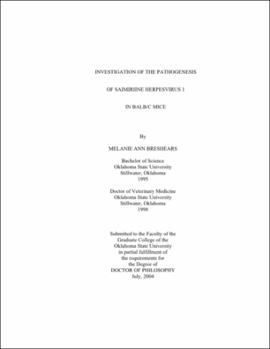| dc.contributor.advisor | Ritchey, Jerry W. | |
| dc.contributor.author | Breshears, Melanie Ann | |
| dc.date.accessioned | 2013-11-26T08:35:13Z | |
| dc.date.available | 2013-11-26T08:35:13Z | |
| dc.date.issued | 2004-07 | |
| dc.identifier.uri | https://hdl.handle.net/11244/7653 | |
| dc.description.abstract | Scope and Method of Study: The purpose of this study was to investigate the pathogenesis of Saimiriine herpesvirus 1 (SaHV-1) infection by characterizing the clinical disease and gross and microscopic lesions in experimentally infected mice. To aid in the identification of anatomic sites of viral replication and to trace viral spread in experimentally infected mice, a green fluorescent protein (GFP)-expressing recombinant strain of SaHV-1 was constructed and used in subsequent inoculation studies. Mice were inoculated intramuscularly or epidermally with ten-fold dilutions of virus and sacrificed at 14 or 21 days in endpoint studies or on sequential days in temporal studies. Serum was tested by ELISA and tissues were examined microscopically with routine stains, immunohistochemistry, and confocal microscopy. | |
| dc.description.abstract | Findings and Conclusions: SaHV-1 inoculation of Balb/c mice, either intramuscularly or epidermally, resulted in active infection as indicated by seroconversion, clinical disease, and gross and microscopic lesions. Mice inoculated intramuscularly initially developed skin lesions in the region of inoculation with subsequent development of paresis or paralysis of the inoculated hindlimb in animals receiving higher doses of virus. Lesions in these mice were restricted to the skin and thoracolumbar spinal cord and consisted of necrotizing dermatitis and segmental myelitis with neuronal necrosis. Mice inoculated with SaHV-1 via epidermal scarification developed a more rapidly progressive, severe disease that began in the inoculated epidermis and spread to involve thoracolumbar spinal cord, regional autonomic ganglia, and lower urinary tract. All mice receiving an infective dose of virus by this route developed ultimately fatal disease. GFP expression, indicating viral replication, corresponded with microscopic lesions and was present in keratinocytes of the epidermis, neurons of the dorsal root ganglia, spinal cord, sympathetic ganglia, and colonic myenteric plexus as well as epithelium of the lower urinary tract. SaHV-1 exhibited neurovirulence in Balb/c mice that varied significantly with the route of inoculation. | |
| dc.format | application/pdf | |
| dc.language | en_US | |
| dc.rights | Copyright is held by the author who has granted the Oklahoma State University Library the non-exclusive right to share this material in its institutional repository. Contact Digital Library Services at lib-dls@okstate.edu or 405-744-9161 for the permission policy on the use, reproduction or distribution of this material. | |
| dc.title | Investigation of the pathogenesis of Saimiriine herpesvirus 1 in Balb/c mice | |
| dc.contributor.committeeMember | Eberle, Richard | |
| dc.contributor.committeeMember | Panciera, Roger J. | |
| dc.contributor.committeeMember | Saliki, Jerry T. | |
| osu.filename | Breshears_okstate_0664D_1036.pdf | |
| osu.accesstype | Open Access | |
| dc.type.genre | Dissertation | |
| dc.type.material | Text | |
| thesis.degree.discipline | Veterinary Biomedical Science | |
| thesis.degree.grantor | Oklahoma State University | |
